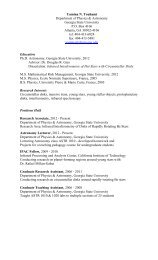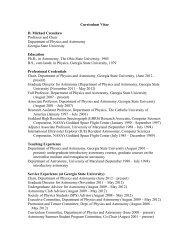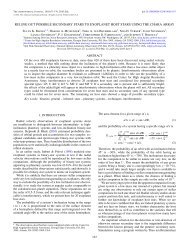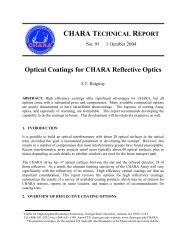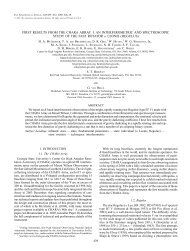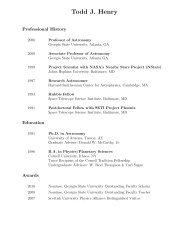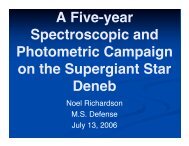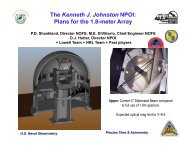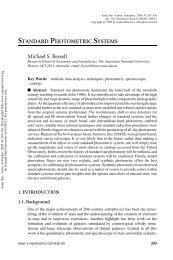Secular and Statistical Parallax
Secular and Statistical Parallax
Secular and Statistical Parallax
Create successful ePaper yourself
Turn your PDF publications into a flip-book with our unique Google optimized e-Paper software.
<strong>Secular</strong> <strong>and</strong> <strong>Statistical</strong> <strong>Parallax</strong><br />
Katie Gordon<br />
December 4 th , 2013
<strong>Secular</strong> <strong>Parallax</strong><br />
Sun moves ~4 AU/yr<br />
Problem: other stars are also moving<br />
Can find average distance to a set of stars<br />
>> Assume velocity of set of stars w.r.t the sun averages to zero<br />
Doesn’t require measurement of radial velocities<br />
Uses components of proper motion parallel to sun’s peculiar<br />
motion<br />
~<br />
1<br />
>> Only good for clusters of stars
= ||<br />
ʘ<br />
From Binney <strong>and</strong> Merrifield (pg. 44)
<strong>Statistical</strong> <strong>Parallax</strong><br />
Assume velocities are isotropically distributed<br />
Assume average value of v t equals average values of v r (when<br />
corrected to sun’s motion)<br />
=<br />
+ ʘ ψ<br />
Or… =<br />
.<br />
.
More general if allow for differential rotation of galaxy<br />
If<br />
>> statistical parallax more reliable<br />
If<br />
∙ ⃑ < ʘ<br />
>> secular more reliable<br />
Good from about<br />
200 – 500 pc
Before Hipparcos, used to get distances to rare, but luminous stars<br />
May be useful again if new astrometric satellite provides extremely<br />
high precision proper motions<br />
In 1913, Hertzsprung used secular<br />
parallax to measure distance to a<br />
classical Cepheid to calibrate<br />
period-luminosity relation
‘Recent’ Results<br />
1978
Used secular parallax to find absolute magnitudes of S stars<br />
Based on absolute magnitudes, concluded that S stars were not<br />
supergiants<br />
Poorly known proper motions<br />
S Stars: - red giants with enhanced s-process elements<br />
-similar to K through M stars<br />
- may be an intermediate stage<br />
between AGB <strong>and</strong> carbon stars
2013
Sample of 242 RR Lyrae c stars<br />
Accurate photometry <strong>and</strong> proper<br />
motions from All Sky Automated<br />
Survey (ASAS) <strong>and</strong> USNO CCD<br />
Astrograph Catalogs (UCAC-2<br />
<strong>and</strong> UCAC-4)<br />
Collected echelle spectroscopy at<br />
Las Campanas Observatory<br />
<br />
First direct determination of absolute magnitude for RRLc stars<br />
<br />
5% error on distance<br />
Also were able to show that UCAC-2 overestimated errors by about 50%
Problems <strong>and</strong> Sources of Error<br />
Depends on accuracy of proper motion measurements<br />
Depends on how well we know solar motion<br />
Makes a lot of assumptions<br />
Can only get average distance for a group of stars
Questions?
References<br />
http://www1.ynao.ac.cn/~jinhuahe/know_base/astro_objects/agbstar/<br />
s_stars.htm<br />
Binney & Merrifield, Galactic Astronomy<br />
Kollmeier, J. A., et al., 2013, ApJ, 775, 57K<br />
Stephenson, C. B., 1978, AJ, 83, 816S



